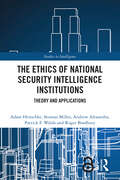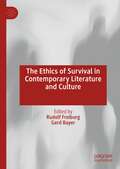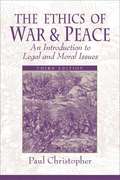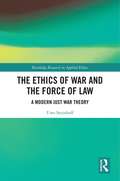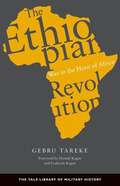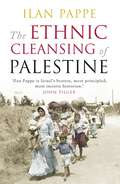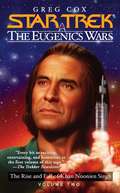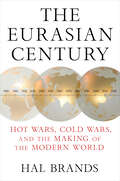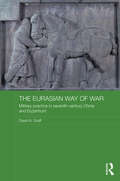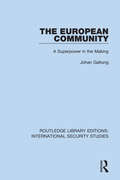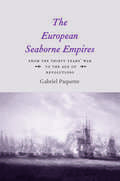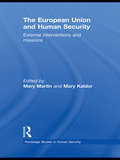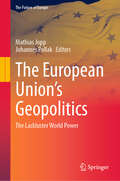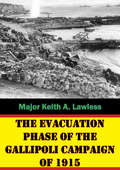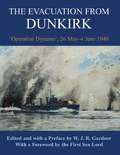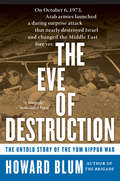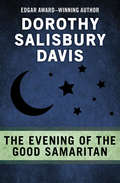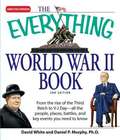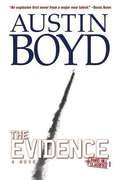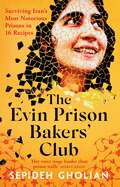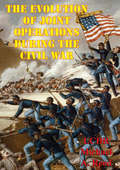- Table View
- List View
The Ethics of National Security Intelligence Institutions: Theory and Applications (Studies in Intelligence)
by Seumas Miller Andrew Alexandra Adam Henschke Patrick F. Walsh Roger BradburyThis book explores the ethics of national security intelligence institutions operating in contemporary liberal democracies.Intelligence collection by agencies such as the CIA, MI6, and Mossad involves practices that are apparently inconsistent with the principles of ordinary morality – practices such as lying, spying, manipulation, and covert action. However, in the defence of national security, such practices may not only be morally permissible, but may also under some circumstances be morally obligatory. One approach to the ethics of national security intelligence activity has been to draw from the just war tradition (so-called ‘just intelligence theory’). This book identifies significant limitations of this approach and offers a new, institutionally based, teleological normative framework. In doing so, it revises some familiar principles designed for application to kinetic wars, such as necessity and proportionality, and invokes some additional ones, such as reciprocity and trust. It goes on to explore the applications of this framework and a revised set of principles for national security intelligence institutions and practices in contemporary and emerging political and technological settings.This book will be of much interest to students of intelligence studies, ethics, security studies and International Relations.
The Ethics of Survival in Contemporary Literature and Culture
by Gerd Bayer Rudolf FreiburgThe Ethics of Survival in Contemporary Literature and Culture delves into the complex problems involved in all attempts to survive. The essays analyze survival in contemporary prose narratives, short stories, poems, dramas, and theoretical texts, but also in films and other modes of cultural practices. Addressing diverse topics such as memory and forgetting in Holocaust narratives, stories of refugees and asylum seekers, and representations of war, the ethical implications involved in survival in texts and media are brought into a transnational critical discussion. The volume will be of potential interest to a wide range of critics working on ethical issues, the body, and the politics of art and literature.
The Ethics of War and Nuclear Deterrence
by James P. SterbaA selection of addresses, essays and lectures on the moral and ethical aspects of war and the strategy of deterrence.
The Ethics of War and Peace: An Introduction to Legal and Moral Issues
by Paul ChristopherThe most important decision that nations make is whether to use force for political objectives. In a democracy, all responsible citizens feel the weight of such decisions.
The Ethics of War and the Force of Law: A Modern Just War Theory (Routledge Research in Applied Ethics)
by Uwe SteinhoffThis book provides a thorough critical overview of the current debate on the ethics of war, as well as a modern just war theory that can give practical action-guidance by recognizing and explaining the moral force of widely accepted law. Traditionalist, Walzerian, and "revisionist" approaches have dominated contemporary debates about the classical jus ad bellum and jus in bello requirements in just war theory. In this book, Uwe Steinhoff corrects widely spread misinterpretations of these competing views and spells out the implications for the ethics of war. His approach is unique in that it complements the usual analysis in terms of self-defense with an emphasis on the importance of other justifications that are often lumped together under the heading of "lesser evil." It also draws on criminal law and legal scholarship, which has been largely ignored by just war theorists. Ultimately, Steinhoff rejects arguments in favor of "moral fundamentalism"— the view that the laws and customs of war must simply follow an immutable morality. In contrast, he argues that widely accepted laws and conventions of war are partly constitutive of the moral rules that apply in a conflict. The Ethics of War and the Force of Law will be of interest to scholars and advanced students working in just war theory, applied ethics, political philosophy, political theory, philosophy of law, and criminal and military law.
The Ethiopian Revolution: War in the Horn of Africa (Yale Library of Military History Series)
by Gebru TarekeRevolution, civil wars, and guerilla warfare wracked Ethiopia during three turbulent decades at the end of the 20th century. Tareke brings to life the leading personalities in the domestic political struggles, strategies of the warring parties, international actors, and key battles.
The Ethnic Cleansing of Palestine
by Ilan PappeThe book that is providing a storm of controversy, from &‘Israel&’s bravest historian&’ (John Pilger)Renowned Israeli historian, Ilan Pappe's groundbreaking work on the formation of the State of Israel. 'Along with the late Edward Said, Ilan Pappe is the most eloquent writer of Palestinian history.' NEW STATESMAN Between 1947 and 1949, over 400 Palestinian villages were deliberately destroyed, civilians were massacred and around a million men, women, and children were expelled from their homes at gunpoint. Denied for almost six decades, had it happened today it could only have been called 'ethnic cleansing'. Decisively debunking the myth that the Palestinian population left of their own accord in the course of this war, Ilan Pappe offers impressive archival evidence to demonstrate that, from its very inception, a central plank in Israel&’s founding ideology was the forcible removal of the indigenous population. Indispensable for anyone interested in the current crisis in the Middle East. *** 'Ilan Pappe is Israel's bravest, most principled, most incisive historian.' JOHN PILGER 'Pappe has opened up an important new line of inquiry into the vast and fateful subject of the Palestinian refugees. His book is rewarding in other ways. It has at times an elegiac, even sentimental, character, recalling the lost, obliterated life of the Palestinian Arabs and imagining or regretting what Pappe believes could have been a better land of Palestine.' TIMES LITERARY SUPPLEMENT 'A major intervention in an argument that will, and must, continue. There's no hope of lasting Middle East peace while the ghosts of 1948 still walk.' INDEPENDENT
The Eugenics Wars: Volume 2 (Star Trek #Vol. 2)
by Greg Cox"A strange, violent period in your history." -- Spock Many unanswered questions remain about the terrible Eugenics Wars that raged on Earth during the 1990s, an apocalyptic conflict that brought civilization to the brink of a new dark age. Centuries later, as Capt. James T. Kirk and the crew of the Starship Enterprise are forced to defend a colony of genetically enhanced humans against Klingon aggression and sabotage, Kirk must probe deeper into the past -- and into the glory days of one of the greatest adversaries he has ever faced. 1992. Almost twenty years ago, Gary Seven and Roberta Lincoln, undercover operatives for an unknown alien civilization, failed to prevent the Chrysalis Project from creating an entire generation of supermen and women, genetically engineered to be stronger, smarter, and more resourceful than ordinary human beings. Now, at last, the children of Chrysalis have grown to adulthood, and are rapidly demonstrating that superior abilities spawn superior ambition. Perhaps the most formidable of this new breed of supermen is the charismatic Khan Noonien Singh. Working behind the scenes of history as head of a vast global conspiracy, Khan's power soon stretches across a quarter of the planet, but that is only the beginning of his grand design. Determined to unite humanity beneath the enlightened rule of a genetic elite, Khan dreams of leading his fellow superhumans to complete and total domination of the world. But several of his gene-engineered brothers and sisters have equally grandiose visions for the future, visions that recognize no one but themselves as supreme ruler. Gary Seven and Roberta watch in horror as the children of Chrysalis wage a covert war against one another, threatening the safety of millions and the future of the entire world! The Eugenics Wars: Volume Two is an earth-shattering thriller that reveals the secret history of the twentieth century -- and the ultimate destiny of the tyrant known as Khan.
The Eurasian Century: Hot Wars, Cold Wars, and the Making of the Modern World
by Hal BrandsOne of Foreign Policy's Most Anticipated Books of 2025 An urgent and incisive new framework for understanding the origins—and stakes—of global conflict with China, Russia, and Iran. We often think of the modern era as the age of American power. In reality, we’re living in a long, violent Eurasian century. That giant, resource-rich landmass possesses the bulk of the global population, industrial might, and potential military power; it touches all four of the great oceans. Eurasia is a strategic prize without equal—which is why the world has been roiled, reshaped, and nearly destroyed by clashes over the supercontinent. Since the early twentieth century, autocratic powers—from Germany under Kaiser Wilhelm II to the Soviet Union—have aspired for dominance by seizing commanding positions in the world’s strategic heartland. Offshore sea powers, namely the United Kingdom and America, have sought to make the world safe for democracy by keeping Eurasia in balance. America’s rivalries with China, Russia, and Iran are the next round in this geopolitical game. If this new authoritarian axis succeeds in enacting a radically revised international order, America and other democracies will be vulnerable and insecure. Hal Brands, a renowned expert on global affairs, argues that a better understanding of Eurasia’s strategic geography can illuminate the contours of rivalry and conflict in today’s world. The Eurasian Century explains how revolutions in technology and warfare, and the rise of toxic ideologies of conquest, made Eurasia the center of twentieth-century geopolitics—with pressing implications for the struggles that will define the twenty-first.
The Eurasian Way of War: Military Practice in Seventh-Century China and Byzantium (Asian States and Empires)
by David A. GraffThis book is a comparative study of military practice in Sui-Tang China and the Byzantine Empire between approximately 600 and 700 CE. It covers all aspects of the military art from weapons and battlefield tactics to logistics, campaign organization, military institutions, and the grand strategy of empire. Whilst not neglecting the many differences between the Chinese and Byzantines, this book highlights the striking similarities in their organizational structures, tactical deployments and above all their extremely cautious approach to warfare. It shows that, contrary to the conventional wisdom positing a straightforward Western way of war and an "Oriental" approach characterized by evasion and trickery, the specifics of Byzantine military practice in the seventh century differed very little from what was known in Tang China. It argues that these similarities cannot be explained by diffusion or shared cultural influences, which were limited, but instead by the need to deal with common problems and confront common enemies, in particular the nomadic peoples of the Eurasian steppes. Overall, this book provides compelling evidence that pragmatic needs may have more influence than deep cultural imperatives in determining a society’s "way of war."
The European Community: A Superpower in the Making (Routledge Library Editions: International Security Studies #7)
by Johan GaltungThis book, first published in 1973, analyses the European Community in a global perspective. It asks and answers two main questions: what does the European Community mean to the masses of the world, and what does it mean to the world community in general? Most critical studies of the EC were made from an internal point of view, and this book is rare in having an external perspective. The author discussed the EC with diverse audiences in 16 countries, and his analyses are invaluable in putting the European project in an international context.
The European Seaborne Empires: From the Thirty Years' War to the Age of Revolutions
by Gabriel PaquetteAn accessible survey of the history of European overseas empires in the seventeenth and eighteenth centuries based on new scholarship In this thematic survey, Gabriel Paquette focuses on the evolution of the Spanish, Portuguese, English, French, and Dutch overseas empires in the seventeenth and eighteenth centuries. He draws on recent advances in the field to examine their development, from efficacious forms of governance to coercive violence. Beginning with a narrative overview of imperial expansion that incorporates recent critiques of older scholarly approaches, Paquette then analyzes the significance of these empires, including their political, economic, and social consequences and legacies. He makes the multifaceted history of Europe’s globe-spanning empires in this crucial period accessible to new readers.
The European Union and Human Security: External Interventions and Missions (Routledge Studies in Human Security)
by Mary Kaldor Mary MartinThis edited book examines European external interventions in human security, in order to illustrate the evolution and nature of the European Union as a global political actor. In 2003, the EU deployed its first external mission under the European Security and Defence Policy (ESDP) with a military force to the former Yugoslav Republic of Macedonia. Since then it has instigated over 18 civilian and military missions to deal with humanitarian crises all over the world. This book presents a series of eight case studies of external interventions by the EU covering the Balkans, Africa, the Middle East, Afghanistan and Indonesia, to illustrate the nature of the EU as a global actor. Using the concept of human security to assess the effectiveness of these missions in meeting the EU’s aim of being a ‘force for good in the world’, this study addresses two key issues: the need for an empirical assessment of EU foreign and security policies based on EU intervention in conflict and post-conflict situations and the idea of 'human security' and how this is applied in European foreign policy. This book will be of great interest to students of European Security, EU politics, human security, post-conflict reconstruction, and IR in general. Mary Kaldor is Co-Director of the Centre for the Study of Global Governance, London School of Economics and Political Science (LSE). Prior to this she worked at Sussex University as Jean Monnet Reader in Contemporary European Studies. Mary Martin is a Research Fellow at the Centre for the Study of Global Governance, the London School of Economics. From 2006-2009 she was co-ordinator of the Human Security Study Group. She was formerly a foreign correspondent and European editor for The Daily Telegraph and Guardian newspapers.
The European Union and Military Force
by Per M. Norheim-MartinsenThe Common Security and Defence Policy maps out how the EU - established primarily to be an economic organisation - can purposefully prepare for and apply the use of military force. In this insightful work, Per M. Norheim-Martinsen argues that, since the EU is not a state but nevertheless does embody some non-intergovernmental characteristics, neither EU studies nor strategic studies is sufficient for fully understanding the Policy itself. Combining the two fields, the author utilises the instrumentality and clarity of the strategic approach, while retaining an understanding of the unique character of the EU as a strategic actor. In so doing, he provides a fruitful conceptual framework for analysing the development of the CSDP, how it functions in practice and how it will continue to evolve in the face of the challenges which lie ahead. This book will appeal to scholars and advanced students of European studies, international relations and strategic studies.
The European Union’s Geopolitics: The Lackluster World Power (The Future of Europe)
by Johannes Pollak Mathias JoppThe book deals with the urgent need for the EU to position itself globally in the wake of Brexit, a rapidly worsening climate crisis, the COVID-19 pandemic, an aggressive Russia, and an ever more assertive China. After 60 years of intensive navel gazing that focused on institutional design more than world politics, the EU is now forced to defend its liberal democratic values, which have come under attack from inside and outside the European integration project. Moreover, Realpolitik is back on the agenda. Europe’s content negligence of defense matters in the past few decades has been revealed by Russia’s war of aggression against Ukraine.
The Evacuation Phase Of The Gallipoli Campaign Of 1915
by Major Keith A. LawlessThis battle study investigates operational and tactical considerations of the battles of Arracourt, which took place in September 1944 as the 4th Armored Division of Patton's Third Army clashed with the Fifth German Panzer Army in the French province of Lorraine on the U.S. drive to the German West Wall.By examining detailed German and American unit histories, logs, and summaries, as well as personal papers, this study illuminates differences and similarities in reporting the U.S. penetration from the Nancy Bridgehead to Arracourt, the German offensive at Lunéville as a prelude to Arracourt, and the two German offensives at Arracourt, as the Fifth Panzer Army attempted to link up with a German unit cut off at Nancy.Arracourt exemplifies penetration and mobile defense and illustrates the demand for good intelligence and flexible command and control. It shows the inherent risks of piecemeal commitment of reserves, the need for timely orders and good logistical support, as well as the tactical advantages of air superiority.
The Evacuation from Dunkirk: 'Operation Dynamo', 26 May-June 1940 (Naval Staff Histories)
by W.J.R. GardnerThis is the Naval Staff History of "Operation Dynamo", originally published internally in 1949. British ships evacuated nearly 100,000 men of the BEF from the beaches, and over 200,000 from harbours. Other nations' vessels carried more than 30,000.
The Eve of Destruction: The Untold Story of the Yom Kippur War
by Howard BlumOn October 6, 1973--Yom Kippur, the holiest day of the Jewish calendar--the Arab world launched a bold and ingeniously conceived surprise attack against Israel. After three days of intense, bloody combat, an unprepared Israel was fighting for survival, while the Arabs, with massive forces closing in on the Jewish heartland, were poised to redeem the honor lost in three previous wars. Based on declassified Israeli government documents and revealing interviews with soldiers, generals, and intelligence operatives on both sides of the conflict, The Eve of Destruction weaves a suspenseful, eye-opening story of war, politics, and deception. It also tells the moving human tale of the men and women who fought to maintain love and honor as their lives and destinies were swept up in the Yom Kippur War.
The Evening of the Good Samaritan
by Dorothy Salisbury DavisBefore, during, and after World War II, three generations of men make their mark on the world in acclaimed author Dorothy Salisbury Davis&’s vibrant, thought-provoking novel that scrutinizes the conscience of men in a time of crisisAs Europe slides toward war, the faculty of a midwestern university fight a crusade of their own—the campaign against Communism. The local publishing magnate has accused economics professor Jonathan Hogan of being a Red, and the scholar is forced to defend himself in front of the university&’s elders. They spare him, for Hogan is no Communist—merely a free thinker, open and honest in an age when conformity is the norm. When war threatens the United States, he is one of those whom his country will need most.Jonathan goes into civil service during the war, advising the government on the economic impacts of the conflict. His son Marcus takes a different route, studying surgery in an attempt to heal those whom the savagery of war has maimed. And, years later, Jonathan&’s grandson Tad will follow his own conscience, too, when he comes violently of age. But what are the consequences of standing by one&’s principles in an era when darkness threatens to overwhelm civilization?
The Everafter War (The Sisters Grimm Book #7)
by Michael BuckleySabrina and Daphne's prayers are finally answered when their parents finally wake up from their sleeping spell. Their happy reunion is short-lived, as they are caught in the middle of a war and shocking secrets are revealed.
The Everyday and Far Away: The perfect bookclub read for fans of Rachel Joyce
by Jacqueline Jones'I was moved to tears by its quiet beauty and layered characters.' Laura Pearson, author of The Last List of Mabel Beaumont For fans of Sally Page and Ruth Hogan, comes this heartwarming tale about love, loss and connection Ernie has had three grand passions in his long life: his dear wife Phyllis, a vintage Norton Dominator motorcycle, and his mini-me son, Stephen. Now, as dementia overwhelms Ernie and takes away everything he can remember about the everyday, memories of those far away times remain crystalline and cherished. His granddaughter Nina, seventeen, is equally at odds with the everyday. Excluded from college for her lack of concentration, it seems a job in her mother&’s greengrocers is the best life can ever offer. Endless time stretches bleakly ahead, yet Nina feels she can barely make it to the end of each day. Until, that is, Nina stumbles upon a surprise which, it turns out, can save both Ernie and herself…
The Everything World War II Book
by David White Daniel P. MurphyFrom Germany's invasion of Poland in 1939 to the official end of World War II on 2 September 1945,The Eveything World War II Book, 2nd Editionprovides readers with detailed information about the war that left no nation untouched. Clear maps and vivid photographs bring this war to life and illustrate the major battles in the European, Pacific, and African theaters. The Everything World War II Book, 2nd Editionis packed with exhaustively researched information. Revised and updated by two experienced historians, this engrossing reference contains new information on the United Nations, World War II memorials, and a timeline of important dates. There's no need to search through stacks of history books -The Everything World Ward Book, 2nd Editionhas all that readers need to learn about this fascinating time in history.
The Evidence (Mars Hill Classified, Book #1)
by Austin BoydAfter waiting his entire life to become an astronaut, John Wells's nearly realized dream is turning into a nightmare. As the nation's capital comes under intense terrorist attack and signs of sophisticated alien life mysteriously appear on the Internet, Wells finds himself increasingly entangled in a web of global deceit---with his marriage, his life, and the planet on the line!
The Evin Prison Bakers' Club: Surviving Iran's Most Notorious Prisons in 16 Recipes
by Sepideh Gholian16 recipes testifying to the sisterhood and solidarity forged in the most notorious prisons in Iran 'A remarkable testimony to women&’s bravery, compassion and solidarity in the harshest of conditions… Think Nigella crossed with Nelson Mandela.' SUNDAY TIMES BOOK OF THE WEEK 'A fighting woman cannot be imprisoned because her voice is louder than prison walls. This book is proof.' Shirin Ebadi, Nobel Peace Prize winner How do you cheer up a woman who has spent hours cleaning prison toilets with a broken mop? The secret is in a tres leches cake. In Iran&’s prisons, women endure horrors: they are beaten, interrogated, and humiliated in a thousand ways. Even a whisper to a fellow inmate can be punished. Yet – in spite of anything and everything – they resist: they bake. They console each other, cry together, dance together. Sepideh Gholian, in prison since 2018, bakes scones, pumpkin pies and madeleines, alongside traditional Iranian sweets. The Evin Prison Bakers&’ Club is a call to stand up for Woman, Life, Freedom by a woman still fighting for a free Iran.
The Evolution Of Joint Operations During The Civil War
by LCDR Michael A. ReedHistory has demonstrated that amphibious assaults are among the most complex and challenging of all joint operations. The myriad of factors that evolved independently throughout the war did not become fully integrated until the winter of 1864-65. This thesis explores the maturation of joint amphibious operations during the U.S. Civil War, specifically through the assaults on Fort Fisher. This analysis will use modern joint doctrine as the framework to compare and contrast the two assaults. It will elaborate on how seaborne assaults differ from riverine assaults. Utilizing Fort Fisher as the focus develops an understanding of the interrelationship of these various factors and the challenges posed in their synchronization to achieve success. This study concludes that the operations reflected jointness, but also marked the emergence of modern amphibious assault concepts.
